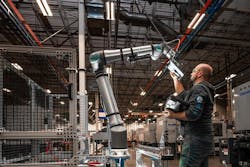Technology, Tariffs and the Pursuit for Supply Chain Flexibility
Key Takeaways:
- Global disruptions demand agility
- Digital natives drive Industry 4.0 adoption
- Speed and quality lead to a competitive advantage
- Flexible redundancy is the new imperative
Unprecedented times in global supply chains continue. The rapidly evolving and fluctuating tariff landscape paints a blurry picture for international sourcing. It also comes on the heels of a turbulent last half decade, including the COVID-19 pandemic, the Suez Canal blockage and numerous geopolitical events such as the Russia-Ukraine war.
From these crises came learnings that companies have used to mitigate these issues. Concurrently, our nation’s manufacturers are quickly adapting new practices to achieve increased levels of agility needed to be partners in navigating today’s tangled supply chains.
Digital Natives Alter Course for Manufacturing Evolution
A sea change in manufacturing was accelerated by the COVID-19 pandemic. Concurrently, multiple retirements of skilled manufacturing professionals occurred in a tight timeframe as manufacturing contracted in response to the pandemic. Companies found that incoming employees, even those with factory floor skills, could not make up for the exodus of manufacturing talent.
The technological evolution launched by today’s manufacturers was driven by this generational shift. Now, digital natives serving as the future of our workforce have joined existing skilled staff with decades of experience. They have driven the adoption of Industry 4.0 capabilities, providing hope for the future.
The rise of automation, machine learning and digital threads connecting front-end e-commerce systems to the manufacturing floor has allowed our industry to enhance both speed and quality during this shift. Manufacturers who have made this technological investment are better positioned to provide much-needed supply chain agility to address today’s tariff environment and beyond.
Today’s leading innovators—often working on tight product development timelines and under pressure to go to market—are taking notice.
Over the last half decade, we have seen many of our customers report that supplier speed has become increasingly vital because of the flexibility it enables. Proximity helps, and the speed at which you can onboard a tech-enabled supplier is a key benefit of tech-enabled manufacturing. These capabilities around speed are, and will continue to be, enormously helpful in reducing lead times during times of disruption.
Manufacturers that can deliver quality parts at speed will prove to be the key to maintaining a modern approach to supply chain agility and market resilience.
Flexibility through Technology
The time it takes to turn a CAD file or drawing into a manufactured part that arrives at your door has historically been prioritized during the prototyping stage. Once the development cycle moves to production, quality rises to the top while speed is deprioritized.
In today’s world, which has no shortage of supply chain disruptions, we are seeing a mindset shift toward a spirit of agility taking hold in the majority of our production customers as well. Our procurement customers now underline both the need for speed and quality in production ordering. The result is coveted flexibility in a supplier relationship when overseas manufacturing partners are inaccessible or cost-prohibitive due to tariffs.
This is not to say we are seeing a global sea change to onshoring. The United Nations Statistics Division had China accounting for just over 28% of manufacturing output in 2018, followed by the United States at 16.6%. Five years later, the same group reported China expanded to 31% while other countries slightly decreased. Of course, that was in the pre-tariff world.
The mindset shift we are witnessing is the rapid prioritization of flexibility within the supply chain. Companies are in search of flexible redundancy: the ability to pivot quickly from an overseas supply chain in times of distress.
In addition to quality parts at speed, suppliers that can navigate disruptions on your behalf within their own manufacturing model accelerate flexible redundancy. Tech-enabled manufacturers that can access stateside factories and a global network of manufacturing partners are an increasingly vital asset as even large companies struggle to quickly reconfigure supply chains due to the extreme time and capital needed.
Manufacturers rooted in Industry 4.0 (and 5.0) are ready to seize this opportunity. Today, our technological evolution leaves us better positioned to provide supply chain flexibility for the next Black Swan event hiding around the corner.
About the Author

Luca Mazzei
Strategic Growth Officer, Protolabs
Luca Mazzei is the strategic growth officer at Protolabs, where he leads product teams maximizing value for customers across all digital manufacturing services. He has more than 25 years of experience in global industrial product and services management. Mazzei is a Fulbright Scholar who holds a Ph.D. in computational mechanics from Stanford University and an MS in aeronautic engineering from the University of Naples in Italy.

